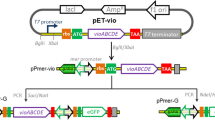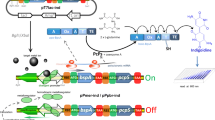Abstract
A colorimetric whole-cell sensor for dimethyl sulfide (DMS) was constructed based on the in vivo conversion of intrinsic pigments in response to the analyte. In a marine bacterium, Rhodovulum sulfidophilum, carotenoids are synthesized via the spheroidene pathway. In this pathway, demethylspheroidene, a yellow carotenoid, is converted to spheroidene under catalysis of O-methyltransferase. Spheroidene monooxygenase (CrtA) catalyzes the terminal step of the pathway and converts spheroidene to spheroidenone, a red carotenoid. Here, the CrtA gene in R. sulfidophilum was removed and then reintroduced downstream of the DMS dehydrogenase gene promoter. Using this whole-cell sensor, 3 μM DMS or dimethyl sulfoxide can be detected without adding any color-forming reagent. The ratio of the red spheroidenone to total carotenoids increased, as the DMS concentration was raised to 0.3 mM. Comparison of the signal to the background color indicated a shift in the color coordinate from a yellow to a red hue. An intense signal was obtained with 1-day incubation at a high cell density when sensor cells at the exponential growth phase were used. These results show that the genetically engineered R. sulfidophilum cells can be used to monitor the quality of marine aquacultural environments by the naked eye.





Similar content being viewed by others
References
Abo M, Ogasawara Y, Tanaka Y, Okubo A, Yamazaki S (2003) Amperometric dimethyl sulfoxide sensor using dimethyl sulfoxide reductase from Rhodobacter sphaeroides. Biosens Bioelectron 18:735–739
Anderson TR, Spall SA, Yool A, Cipollini P, Challenor PG, Fasham MJR (2001) Global fields of sea surface dimethylsulfide predicted from chlorophyll, nutrients and light. J Mar Syst 30:1–20
Armstrong GA, Alberti M, Leach F, Hearst JE (1989) Nucleotide sequence, organization, and nature of the protein products of the carotenoid biosynthesis gene cluster of Rhodobacter capsulatus. Mol Gen Genet 216:254–268
Armstrong GA, Schmidt A, Sandmann G, Hearst JE (1990) Genetic and biochemical characterization of carotenoid biosynthesis mutants of Rhodobacter capsulatus. J Biol Chem 265:8329–8338
Davis BK, Aquilino SA, Lund PS, Diaz-Arnold AM, Denehy GE (1992) Colorimetric evaluation of the effect of porcelain opacity on the resultant color of porcelain veneers. Int J Prosthodont 5:130–136
Fortner B, Meyer TE (1997) Number by colors: a guide to using color to understand technical data. Telos, Santa Clara, CA
Hanlon SP, Holt RA, Moore GR, McEwan AG (1994) Isolation and characterization of a strain of Rhodobacter sulfidophilus: a bacterium which grows autotrophically with dimethylsulphide as electron donor. Microbiology 140:1953–1958
Jonkers HM, van Bergeijk SA, van Gemerden H (2000) Microbial production and consumption of dimethyl sulfide (DMS) in a sea grass (Zostera noltii)-dominated marine intertidal sediment ecosystem (Bassin d'Arcachon, France). FEMS Microbiol Ecol 31:163–172
Keen NT, Tamaki S, Kobayashi D, Trollinger D (1988) Improved broad-host-range plasmids for DNA cloning in gram-negative bacteria. Gene 70:191–197
Lang HP, Cogdell RJ, Takaichi S, Hunter CN (1995) Complete DNA sequence, specific Tn5 insertion map, and gene assignment of the carotenoid biosynthesis pathway of Rhodobacter sphaeroides. J Bacteriol 177:2064–2073
Maeda I, Chowdhury WQ, Idehara K, Yagi K, Mizoguchi T, Akano T, Miyasaka H, Furutani T, Ikuta Y, Shioji N, Miura Y (1998) Improvement of substrate conversion to molecular hydrogen by three-stage cultivation of a photosynthetic bacterium, Rhodovulum sulfidophilum. Appl Biochem Biotechnol 70–72:301–310
Maeda I, Miyasaka H, Umeda F, Kawase M, Yagi K (2003) Maximization of hydrogen production ability in high-density suspension of Rhodovulum sulfidophilum cells using intracellular poly(3-hydroxybutyrate) as sole substrate. Biotechnol Bioeng 81:474–481
Maeda I, Yamashiro H, Yoshioka D, Onodera M, Ueda S, Miyasaka H, Umeda F, Kawase M, Takaichi S, Yagi K (2005) Unusual accumulation of demethylspheroidene in anaerobic-phototropic growth of crtA-deleted mutants of Rhodovulum sulfidophilum. Curr Microbiol (in press)
Masuda S, Yoshida M, Nagashima KV, Shimada K, Matsuura K (1999) A new cytochrome subunit bound to the photosynthetic reaction center in the purple bacterium, Rhodovulum sulfidophilum. J Biol Chem 274:10795–10801
McDevitt CA, Hugenholtz P, Hanson GR, McEwan AG (2002) Molecular analysis of dimethyl sulphide dehydrogenase from Rhodovulum sulfidophilum: its place in the dimethyl sulphoxide reductase family of microbial molybdopterin-containing enzymes. Mol Microbiol 44:1575–1587
Sambrook J, Fritsch EF, Maniatis T (1989) Molecular cloning: a laboratory manual, 2nd edn. Cold Spring Harbor Laboratory Press, New York
Simon R, Priefer U, Pühler A (1983) A broad host range mobilization system for in vivo genetic engineering: transposon mutagenesis in gram negative bacteria. Bio/technology 1:784–791
Takaichi S (1999) Carotenoids and carotenogenesis in anoxygenic photosynthetic bacteria. In: Frank HA, Young AJ, Britton G, Cogdell RJ (eds) The photochemistry of carotenoids. Kluwer, Dordrecht, the Netherlands, pp 39–69
Takaichi S, Jung DO, Madigan MT (2001) Accumulation of unusual carotenoids in the spheroidene pathway, demethylspheroidene and demethylspheroidenone, in an alkaliphilic purple nonsulfur bacterium Rhodobaca bogoriensis. Photosynth Res 67:207–214
Toole DA, Siegel DA (2004) Light-driven cycling of dimethylsulfide (DMS) in the Sargasso Sea: closing the loop. Geophys Res Lett 31(L09308):1–4
Vogt C, Rabenstein A, Rethmeier J, Fischer U (1997) Dimethyl sulphoxide reduction with reduced sulphur compounds as electron donors by anoxygenic phototrophic bacteria. Microbiology 143:767–773
Yeliseev AA, Eraso JM, Kaplan S (1996) Differential carotenoid composition of the B875 and B800–850 photosynthetic antenna complexes in Rhodobacter sphaeroides 2.4.1: involvement of spheroidene and spheroidenone in adaptation to changes in light intensity and oxygen availability. J Bacteriol 178:5877–5883
Yoch DC (2002) Dimethylsulfoniopropionate: its sources, role in the marine food web, and biological degradation to dimethylsulfide. Appl Environ Microbiol 68:5804–5815
Yun CH, Beci R, Crofts AR, Kaplan S, Gennis RB (1990) Cloning and DNA sequencing of the fbc operon encoding the cytochrome bc 1 complex from Rhodobacter sphaeroides. Characterization of fbc deletion mutants and complementation by a site-specific mutational variant. Eur J Biochem 194:399–411
Acknowledgements
This work was supported by a grant-in-aid from the Japan Society for the Promotion of Science to I.M. (13780423).
Author information
Authors and Affiliations
Corresponding author
Rights and permissions
About this article
Cite this article
Maeda, I., Yamashiro, H., Yoshioka, D. et al. Colorimetric dimethyl sulfide sensor using Rhodovulum sulfidophilum cells based on intrinsic pigment conversion by CrtA. Appl Microbiol Biotechnol 70, 397–402 (2006). https://doi.org/10.1007/s00253-005-0117-4
Received:
Revised:
Accepted:
Published:
Issue Date:
DOI: https://doi.org/10.1007/s00253-005-0117-4




